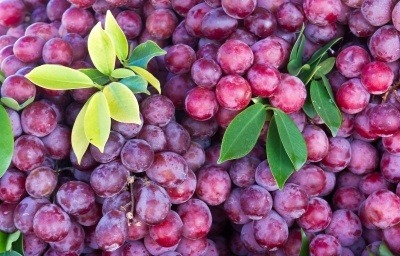
Pterostilbene is one of the stress metabolites produced by the grape, Vitis vinifera along with resveratrol, ε-viniferin, and α-viniferin in response to infection (Langcake, 1981). Pterostilbene is structurally related to resveratrol and is touted like its relative, also a phytoalexin with helping to improve heart health when taken as a supplement.
It is also found in other plant berries such as blueberries too.
In nutritional terms, pterostilbene acts similarly to resveratrol in many respects. It has antioxidant activity (Stivala et al., 2001) some basis with cancer chemoprevention (Rimando et al., 2002), antidiabetic properties and is cytotoxic with a number of cell lines in vitro. properties . Pterostilbene has antidiabetic (Manickman et al., 1997) properties and is cytotoxic to a number of cancer cell lines in vitro (Rimando et al., 1994).
An Ayurvedic preparation for aiding heart health (a cardiotonic) called Darakchasava, has Vitis Vinifera as the main ingredient, and contains resveratrol and pterostilbene (Paul et al., 1999). It is likely to be a potent combination found in a number of western over the counter preparations too.
It is marketed as an anti-aging compound as it may improve cognitive function, and serve to manage blood lipid levels. Pterostilbene is available as a supplement in vegetarian capsules from Swanson (50mg capsules), Source Naturals (50mg capsules), Bio Nutrition (100mg capsules) and in combination with resveratrol as a 250mg offering from Reserveage Organics.
References
Langcake, P. (1981) Disease resistance of Vitis spp. and the production of the stress metabolites resveratrol, ε-viniferin, α-viniferin and pterostilbene. Physiol. Plant Pathol. 18(2) pp. 213-226
Manickam, M., Ramanathan, M., Jahromi, M. A. F., Chansouria, J. P. N., Ray, A. B. (1997) Antihyperglycemic activity of phenolics from Pterocarpus marsupium. J. Nat. Prod. 60 pp. 609-610
Paul, B., Masih, I., Deopujari, J., Charpentier, C. (1999) Occurrence of resveratrol and pterostilbene in age-old Darakchasava, an Ayurvedic medicine from India. J. Ethnopharmacol. 68 pp. 71-76.
Rimando, A. M., Cuendet, M., Desmarchelier, C., Mehta, R. G., Pezzuto, J. M., Duke, S. O. (2002) Cancer chemopreventive and antioxidant activities of pterostilbene, a naturally occurring analogue of resveratrol. J. Agric. Food Chem. 50 pp. 3453- 3457.
Rimando, A. M., Pezzuto, J. M., Farnsworth, N. R., Santisuk, T., Reutrakul, V. (1994) Revision of the NMR assignments of pterostilbene and dihydrodehydro-diconiferyl alcohol: Cytotoxic constituents from Anogeissus acuminata. Nat. Prod. Lett. 4, pp. 267-272.
Stivala, L. A., Savio, M., Fedarico, C., Perucca, P., Bianchi, L., Magas, G., Forti, L., Pagnoni, U. M., Albini, A., Prosperi, E., Vannini, V. (2001) Specific structural determinants are responsible for the antioxidant activity and the cell cycle effects of resveratrol. J. Biol. Chem. 276, pp. 22586-22594.
Hi, I have been using Active Health’s pterostilbene for many years and I guess its because it has similar properties to resveratrol. I read that it is a form of this drug and given it is ‘natural’ anyway, I thought it was worth following up on. I’m also on meds for heart disease and I’m carful with this one because I was told it could raise my cholesterol levels but I manage those very effectively. Can you write a bit more about this one ? I like the web-site because the articles are short enough and easy to read. Some of the other web-sites just blind me with crazy science which is annoying to say the least !